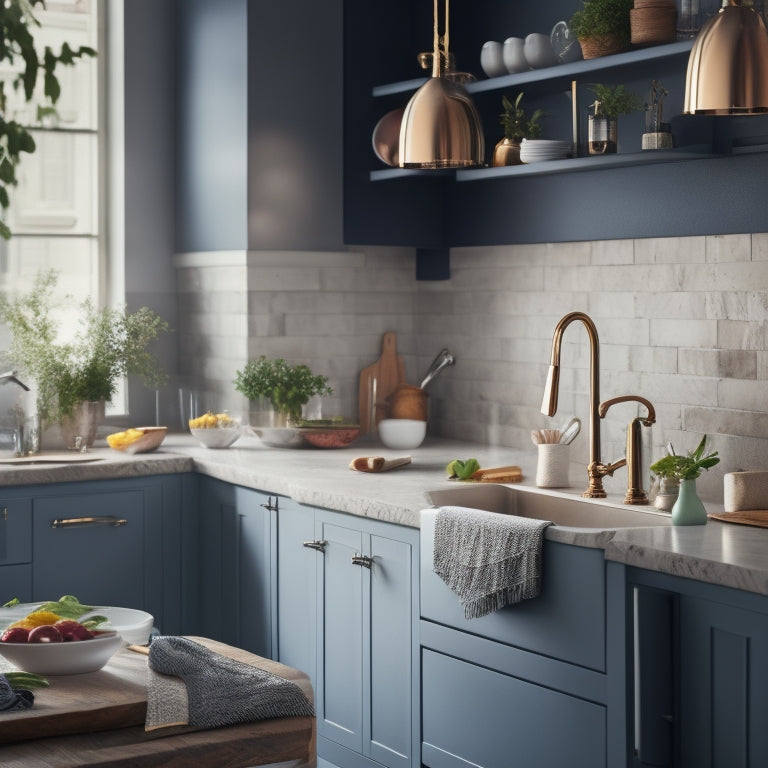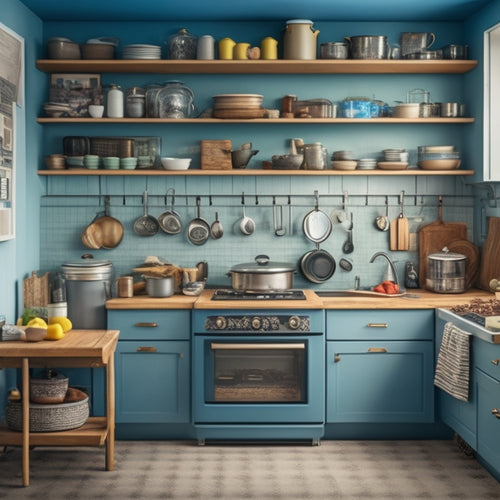
Expert Tips for Perfect Kitchen Sink Selection
Share
When choosing the perfect kitchen sink, it is important to consider multiple factors. Accurate countertop measurements and sink dimensions in relation to cabinetry and appliances are vital for ideal placement. Assess basin configurations, faucet hole options, and material choices like stainless steel and granite composite to meet user needs. Additional features such as built-in accessories, workstation sinks, and drainboards can improve efficiency. Durability and maintenance requirements must also be evaluated, including material strength, regular upkeep, and avoiding harsh chemicals. By carefully considering these factors, you will be well on your way to creating a seamless and functional kitchen space that meets your requirements.
Key Takeaways
• Accurate countertop measurements are crucial to ensure a seamless sink installation that complements cabinetry and appliances.
• Evaluate sink configurations, materials, and types to meet user needs, workflow, and kitchen style, considering factors like durability and aesthetic appeal.
• Consider additional features like built-in accessories, workstation sinks, and drainboards to enhance functionality, organization, and workflow.
• Assess sink durability and develop a maintenance routine to prevent abrasions, rust, and blockages, and preserve the finish integrity.
• Optimize sink placement to improve posture and cooking efficiency, aligning plumbing fixtures and sink dimensions for a comfortable and efficient cooking experience.
Assessing Sink Size and Placement
When selecting a kitchen sink, determining the ideal size and placement is important, as it directly impacts the functionality and workflow of the entire kitchen. Measuring countertops accurately is crucial to optimize space and guarantee a seamless fit.
Consider the sink's dimensions in relation to the surrounding cabinetry, appliances, and workflow patterns. Aligning plumbing fixtures with the sink's placement is crucial to maximize comfort and ease of use. A well-placed sink can improve posture, reduce strain, and enhance overall cooking efficiency.
Choosing the Right Sink Configuration
With the ideal sink size and placement determined, the next step is to select a sink configuration that complements the kitchen's unique workflow patterns and accommodates the needs of its users. This involves considering the basin configuration, which can be single, double, or triple, and the drain placement, which can be off-center, centered, or rear.
-
Evaluate the benefits of each basin configuration, such as the extra space provided by a double basin or the streamlined workflow of a single basin.
-
Consider the faucet hole options, which can range from one to four or more, depending on the sink's intended use and accessories.
-
Compare the material options, such as stainless steel, copper, or granite composite, to determine the best fit for the kitchen's style and functionality.
- Assess the sink's overall design to make sure it meets the needs of its users and enhances the kitchen's workflow.
Exploring Sink Materials and Types
Choosing the correct sink material and type is an important decision, as it greatly affects the overall aesthetic, durability, and maintenance needs of the kitchen sink.
When exploring sink materials, consider the aesthetic appeal of stainless steel, copper, granite composite, cast iron, and fireclay sinks. Each material offers unique benefits, such as resistance to corrosion, scratches, or heat. Compare sink material comparisons to determine the best fit for your kitchen style and needs.
Additionally, examine types of sink finishes, such as matte, glossy, or brushed, and their durability considerations. For instance, a matte finish may hide fingerprints, while a glossy finish may be more prone to scratches.
Evaluating Additional Sink Features
Beyond the fundamental considerations of sink material and type, additional features can greatly enhance the functionality, organization, and overall workflow of your kitchen. These features can make a significant difference in your daily cooking and cleaning routine.
Consider sinks with built-in accessories like cutting boards, basin racks, and drainboards that provide extra counter space and storage.
Workstation sinks with ledges for sliding colanders and drying racks can further enhance efficiency.
Drainboards can aid in drying dishes and maintaining a clean countertop, promoting organization and reducing clutter.
Sink accessories like soap dispensers, hot water taps, and instant hot water dispensers can also contribute to a more streamlined kitchen experience.
Considering Sink Durability and Maintenance
When it comes to selecting the ideal kitchen sink, resilience and upkeep requirements are crucial aspects to consider, as they can significantly impact the sink's performance and longevity over time. To guarantee your sink remains operational and visually appealing, contemplate the following durability factors and maintenance tips:
| Resilience Factors | Maintenance Tips | Advantages |
|---|---|---|
| Material strength | Regular upkeep | Prevents abrasions and rust |
| Finish integrity | Refrain from using harsh chemicals | Preserves luster and look |
| Drain performance | Conduct regular drain care | Averts blockages and unpleasant smells |
Comparing Prices and Reading Reviews
In the pursuit of finding the perfect kitchen sink, understanding the nuances of pricing and customer feedback becomes a vital step in making an informed decision. It's important to research and compare prices from different brands and models to guarantee you're getting the best value for your money.
-
Consider the brand reputation and warranty coverage when evaluating prices.
-
Read customer reviews to gain insights into the sink's performance and durability.
-
Look for patterns in customer feedback to identify potential issues or areas of excellence.
- Balance price comparison with customer reviews to make an informed decision that meets your needs and budget.
Making an Informed Sink Decision
With a clear comprehension of the price spectrum and customer feedback, it's now time to synthesize this information into a well-informed decision that aligns with your kitchen's unique needs and aesthetic.
Consider how sink aesthetics, such as material and color, will complement your kitchen's style. Evaluate the sink's functionality, including basin configuration, depth, and counter space, to guarantee it meets your cooking and cleaning requirements.
Don't forget to assess sink installation and plumbing considerations, including the type of mount and drain placement, to guarantee a seamless integration with your kitchen's infrastructure.
Frequently Asked Questions
Can a Kitchen Sink Be Installed Without a Window Above It?
A kitchen sink can be installed without a window above it, considering factors like sink material options, such as stainless steel or fireclay, and kitchen sink styles, like undermount or farmhouse, to create a functional and visually appealing space.
Are Kitchen Sinks With Built-In Water Filters a Good Idea?
Kitchen sinks with built-in water filters offer enhanced water quality and filtration, while also elevating sink aesthetics and functionality, providing a sleek, modern look and convenient access to clean drinking water.
Do Kitchen Sink Drains Come With Built-In Garbage Disposals?
The quest for a kitchen sink that does it all! Ironically, built-in garbage disposals are not a standard feature in kitchen sink drains, but some sink materials, like stainless steel, are compatible with disposals, and drain size, installation options, and compatibility vary by brand.
Can a Kitchen Sink Be Replaced Without Replacing the Countertops?
Yes, a kitchen sink can be replaced without replacing the countertops, provided the new sink material is compatible with the existing countertop and plumbing connections, ensuring a seamless integration that preserves countertop aesthetics.
Are Touchless Kitchen Sinks More Hygienic Than Traditional Ones?
"A million germs await on traditional kitchen sinks, but touchless models revolutionize hygiene! With reduced maintenance requirements and comparable costs, they promote efficiency and water conservation, giving homeowners ultimate control over a cleaner, healthier kitchen environment."
Related Posts
-

Healthy Breakfast Snacks for Mornings on the Run
We know that when you are on the run it is difficult to cook breakfast and even worse to eat healthy! That’s why we f...
-

10 Best Digital Solutions for Renters' Kitchen Chaos
You're tired of kitchen chaos, where cluttered counters and disorganized cupboards make meal prep a nightmare. It's t...

